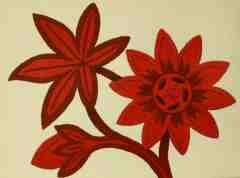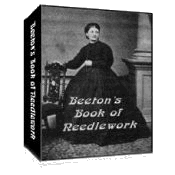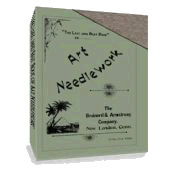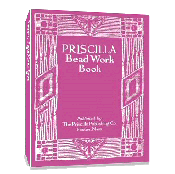Applique Victorian Style
In this article, included under the name of Applique, or “applied” work, is every sort of embroidery which, being worked solidly on one material, is then cut out and laid down upon another, and secured by various ornamental stitches.

Applique on Linen
Click on Picture for more detail
This is rather a rough-and-ready definition, and requires amplification. Suppose, for instance, that a certain material is to be ornamented by having a group of flowers repeated over the surface at regular intervals. The group of flowers, or what not, is worked on some stout ground, such as Holland or coarse linen; when finished so far, the work is cut out carefully, the scissors following round the edge of the work about a quarter of an inch or half an inch away, according to the size and nature of the work; the work is then laid upon the ground material, which is ready stretched in a frame. When a spray of flowers is well in its place, care being taken that every leaf shall be duly laid and no curve pulled the least out of shape, the raw edges are secured by firm stitches, and the whole design is edged with a gold thread, or a twist of silk or wool, or with a gimp or braid, according to the nature of the materials which are being dealt with. This method of work is, in fact, considerably modified by the materials employed.

Cloth Applique
For a great bold Applique wall-hanging in wools on serge the same nicety of finish should not show that would be required for a delicate piece of work in fine silk and gold thread, to be laid on a choice bit of satin. In the former, the cut edges would be covered by the broad gimp or cord surrounding the design, whereas in the finer work the edges, wherever possible, must be dexterously tucked away underneath; for the slim outline will not hide any unevenness here, and nothing looks so clumsy and ugly as a thick outline too heavy the design. This turning-in of edges and sewing down very neatly is the most troublesome part of the work, and requires deft fingers. One has to be careful not to cut too near the work, nor too deep into the corners; but the broader the margin left, the more tiresome it is to turn in neatly, especially if the design is small or the least bit intricate. The design for such work should be of the simplest and broadest; leaves should have a simple outline, or if serrated the serrations can be shown by two or three little stitches within the outline.
Compare, for instance, Fig. 1 and Fig. 2, in which two different forms of design are shown, is suitable for Applique work, and the other unsuited to it. In Fig. 1 below, a conventionalized bud and leaf are drawn simply and even crudely, but drawn in a way that suffices for use in Applique.

Click on picture to see more detail.
In Fig. 2, below, on the other hand, a chrysanthemum with its deeply serrated leaf is drawn, also conventionalized.

Click on picture to see more detail.
There would be nothing elaborate or troublesome in this if worked in some stitches but in the form of work discussed here would be almost impossible to do neatly. It really makes no sense in trying to conquer impossibilities when there is a straight and simple way of doing what is wanted. Now, the very fact that broad and simple forms are a sine qua non in this method, makes the work very well adapted for decoration that is intended to catch the eye at a distance; but for richer work to be admired and handled more elaboration will be wanted in finishing. Flourishes and tendrils can be added, or a whole background pattern introduced behind the solid Applique groups. This sort of “tracery” seems to give a coherence to the heavier parts of the design, and is very helpful in enriching and lightening it.
Applique is not a stitch or series of stitches, but a certain method of work, irrespective of the stitches employed therein. But certain stitches are more adapted than others for working the groups and sprays to be applied. The more solid stitches will, of course, be used, and the various sorts of raised couching, especially gold couching, are perhaps the best for this purpose, and the stiffer worked the better. Botticelli, the Florentine artist, is said by his historian, Vasari, to have been especially fond of this work and to have made designs for it. Vasari, indeed, said that he invented it, but it is suspected this of being a flight of the historian's imagination, which was lively at times, and not likely to err on the side of understating the case.

Applique on Damask
Click on picture to see more detail.
A simple form of applied work that is far from costly so far as concerns time and material, and yet effective, consists of cutting out shapes in colored cloth or silk, and laying them directly on the material to be ornamented, and then connecting the whole with outlines and what veining and marking of leaf and so forth the design seems to require for its completion. Even this simple work should be put into an embroidery frame; it is so much easier to manipulate the work when both hands are at liberty.

Applique on Muslin
The above article, found in Decorative Needlework by May Morris, 1893, was edited for use on this site. Note that many of the pictures or diagrams are not a part of the original article but were added to show some of the many types of appliqué that exist.
Return to top of Applique page.
Return to Types of Embroidery page.
The Last and Best Book of Art Needlework
Over 100 pages of authentic Victorian instructions and patterns from 1895!
FREE
Beeton's Book Of Needlework

433 pages!
Sign up for VEAC! Everything you wanted to know about Victorian embroidery, needlework, crafts and more!
Priscilla Bead Work Book
Make Beautiful Victorian Beaded Purses, Jewelry & Accessories - Starting
TODAY!



